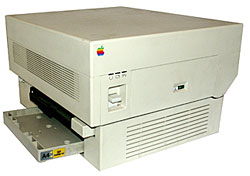The Publishing Revolution
The Macintosh (with its brief forerunner the Lisa) in 1984 and the LaserWriter in 1985 took publishing from the printing press to the desktop.
The Macintosh
The Macintosh was revolutionary in that a paper-like white display showed on screen exactly what would be printed (WYSIWYG or What You See is What You Get). Other computers showed green print on a black screen in a monospaced typeface with complex codes indicating formatting.
The Macintosh also made a huge leap forward with the introduction of the graphical user interface we now take for granted. Instead of a "command line", the graphical interface used Window, Icon, Menu and Pointing device (WIMP). The mouse made it possible to easily access the screen, just as a pencil draws on paper, leading to graphics and the imaging revolution.
Reports, essays, brochures, newsletters and all manner of other printed works, with combined text and graphics, could now be produced on the desktop. But dot matrix printers lacked the sharpness of the printing press.
The Apple LaserWriter
 The Apple LaserWriter (1985) completed the leap forward by providing a means of printing text and graphics
at a quality comparable with that of the professional printing press. In technical terms, this was accomplished
by use of a page description language called Adobe PostScript, which supported printing of scalable text and
graphics at high resolution.
The Apple LaserWriter (1985) completed the leap forward by providing a means of printing text and graphics
at a quality comparable with that of the professional printing press. In technical terms, this was accomplished
by use of a page description language called Adobe PostScript, which supported printing of scalable text and
graphics at high resolution.
Initially PostScript laser printing was expensive because it required huge processing power. Over 8 million dots had to be mapped and fed in an uninterrupted stream to the laser. This data processing could not be done on a host computer because, at the time, there was no way to move that amount of data fast enough through the printer port. The solution was to build another computer inside the laser printer, with enough RAM to cope with all the dots in one stream.
The expense of laser printing was more acceptable on the Mac because networking was built in from the start, enabling one printer to be shared easily between Macs, using simple-to-implement AppleTalk networking.
Specialist desktop publishing software such as Aldus PageMaker (1985) made it easy to combine text and graphics for printing.
This software was made possible because the Macintosh had the hardware to support it. With the Macintosh, Apple made a bold move from 5.25 inch floppy disks to 3.5 inch floppies. A second or external floppy drive was a lower cost storage option offered by Apple until hard drives became affordable. It enabled printing businesses to access material supplied by clients on floppy disk.
<< back to The Apple Effect homepage
^ top of page
Five revolutions that changed your life
- Personal Computing
- Publishing
- Imaging
- Video
- Audio
 Publishing
Revolution podcasts
Publishing
Revolution podcasts
To download these files onto your computer, control-click (right-click) on the link and select "download linked file" (Safari) or "save link as" (Firefox). Double-click or drag the file into iTunes and it will play.
Ian Godfrey talks about how the Apple II revolutionised his life:
download mp3 formatted podcast 6.18MB
download AAC (m4a enhanced) formatted podcast 3.31MB
Kerrie Mullins-Gunst talks about how the Mac 512, MacWrite and MacPaint revolutionised her life:
download mp3 formatted podcast 4.12MB
download AAC (m4a enhanced) formatted podcast 2.14MB
Noel Jackling talks about how the MacWrite, MacDraw and MacPaint revolutionised his life:
 internet macintosh user group!
internet macintosh user group!